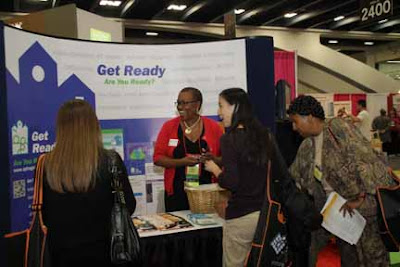"It is our responsibility to inspire each other."
Those were words from this afternoon's Closing Session speaker, author and social justice activist Angela Davis, who spoke to a standing room-only crowd on "Incarceration, Justice and Health." She began her time on stage expressing her sadness for those who now face the aftermath of Superstorm Sandy. But she quickly followed it up with anger at the many who continue to dismiss human responsibility for global warming.
She brought that energizing tone to her next topic: mass incarceration. She said it's a problem that's reached crisis proportions and for which racism plays no small part. In fact, Davis said the nation's prison industrial complex feeds on, benefits from and only entrenches structural racism. She noted that while blacks represent only 13 percent of the U.S. population, they make up nearly half of the overall prison population (Latino residents and American Indians are also disproportionately represented.) Shockingly, 25 percent of the world's incarcerated population is in the United States, home to only 5 percent of the global census, she said.
"Mass incarceration is in itself a public health hazard," Davis said.
Unfortunately, she noted that there are those who contend that some people are simply more inclined to commit criminal acts than others. But they forget — or dismiss — that certain communities are "saturated" with surveillance. While other communities may have similar rates of drug use or trafficking, there simply aren't any police there to catch them, she said.
"It's such a simple explanation as to why the vast majority of people in prison...come from a few ZIP codes," she told attendees, who could be heard murmuring in agreement.
Solving the problem is complex and like the practice of public health, it means focusing on institutions, not just on individuals, she said. People are yearning for a collective vision for a better future, but instead of responding to those needs, "we incarcerate them and pretend the problem has evaporated," she said.
"Imprisonment creates the illusion that we are addressing the problem," Davis told the crowd. "When in actuality, the problem is only being reproduced."
Davis said the struggle to free our communities from oppression goes beyond our borders — "if we are examining incarceration, justice and health, we cannot limit our field of vision to our immediate communities; it is especially important to move beyond the boundaries of the nation." She noted that more than 400,000 people are held in immigration facilities every year and that private prison corporations have a direct interest in the passage of anti-immigrant legislation.
"But people who are called illegal are showing us the way to democracy," she said. "No human being is illegal."
She encouraged attendees to think of themselves as global citizens, to see their struggles as intertwined with struggles happening in all corners of the world.
"Justice is never partial," Davis said. "Justice is always indivisible. Injustice anywhere is an injustice everywhere. We need peace, equality, justice and health."
Davis continued during the Q&A with this beautiful closing quote: "When one learns how to engage in these struggles for larger causes...one sees one's light as inseparate from that process and it puts things in perspective."
Let's cap off this year's blog and Annual Meeting, which welcomed more than 12,500 attendees, with five charges from new APHA President Adewale Troutman. During his Closing Session speech, Troutman called on attendees to: bring five new APHA members to next year's Annual Meeting in Boston, where the theme will be "Think Global, Act Local: Best Practices Around the World;" stand up and take a leadership position in APHA; increase your personal knowledge of the APHA policy process; educate your local policymakers about APHA and its public health priorities; and lastly, stand for justice.
"Remember: The power of one is real," Troutman said.
See you next year in Boston for the 141st APHA Annual Meeting!
— K.K.
Above from top to bottom: Closing session speaker Angela Davis; the passing of the ceremonial gavel from immediate past APHA President Melvin Shipp (left) to new APHA President Adewale Troutman; and a pic of the Closing Session crowd. Photos courtesy Jim Ezell/EZ Event Photography



































